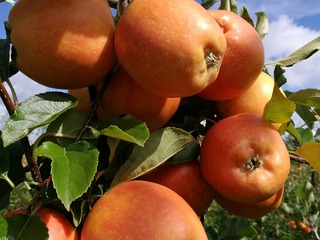
At NIAB EMR the combination of cutting-edge molecular biology and informatics tools, an understanding of plants and microbes at the cellular and organismal level and the downstream application into breeding programmes place the department at the heart of future efforts to increase resilience to global challenges.
There are currently seven research themes within NIAB EMR's Genetics, Genomics and Breeding department:
- crop breeding and genetics
Principally focussed on commercial breeding programmes of Rosaceous (strawberry, raspberry, cherry, apple and pear) with research projects aligned to underpin these programmes and address and understand the inheritance of key commercial traits and mechanisms. The expansion of current breeding programmes to include blackberry, blueberrry and lonicera is underway, expanding the range of expertise offered by NIAB EMR. Key areas of research include flagship molecular-assisted breeding programmes in horticultural crops, speed breeding and genomic selection.
- durable disease resistance
Investigating and deploying durable disease resistance into economically important crops. Underpinning this is the desire to understand the interaction between plants and pathogens. By using this information to study the mechanisms of resistance, it will advance our scientific knowledge to improve crop production in a sustainable way. Key areas of research include resistance mechanisms, evolution of host resistance and resistance strategies.
- fruit development and quality
Investigating the important components of fruit quality and development in tomato and strawberry. Underpinning this theme is the identification of specific characteristics implicated in yield (i.e photosynthesis), and the aroma and flavour profile of fruits. The knowledge gained here will be used to develop new varieties with higher yields, improved flavour and quality suitable for commercial utilisation. Key areas of research include molecular development of fruit secondary metabolism and meristem identity.
- imaging and measurement technologies
Focused on the investigation and the application of current imaging and data mining techniques to plant science. Driven by the incredible advances in genomics over the past decade, image analysis technologies will be developed to establish standards for objective and high-throughput phenotyping in plant biology. Key areas of research include automating yield prediction, hyperspectral imaging for precision horticulture and the internet of things and horticulture.
- microbial and population genomics
Uunderstanding and harnessing microbial diversity of both pathogenic and beneficial microbes associated with horticulture. It will involve going from population level data to candidate DNA regions associated with phenotypes of interest that can be functionally validated. It will also explore what evolutionary processes drive the expansion of pathogen populations and how growing systems affect this. Key areas of research include host specificity, population dynamics of pests and pathogens and genome evolution
- technology development
Technology enables nearly all modern research. It defines which assays are possible, and their speed and cost – thereby defining possible experiments. Technology development must be married to a pressing biological need. The NIAB EMR TD group is embedded within a department of biologists to ensure understanding of the biological problems that need to be solved. The theme itself is multidisciplinary e.g. cell biology/genetics, molecular biology, bioinformatics, and more recently automation and machine learning. For NIAB EMR and the NIAB group, agricultural academics and the food industry the clearest needs are to improve the speed of genetic improvement in breeding and better pathogen surveillance and diagnostics. Key reas of research include developing and deploying New Breeding Techniques, rational design of plants and microbes, novel foods and single cell genomics.
- statistical genetics and informatics
Modern breeding requires the latest developments in quantitative genetics to be married to bioinformatics, in order to optimise breeding through prediction of crop performance using high volumes of phenotypic and genotypic data. Key areas of research include quantitative genetics and genomic selection, comparative genomics and novel software and applications.
